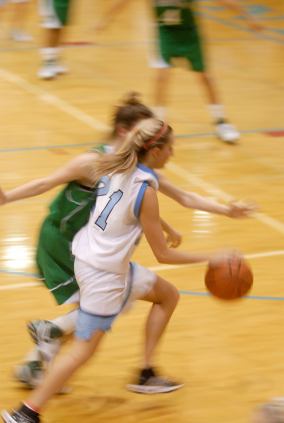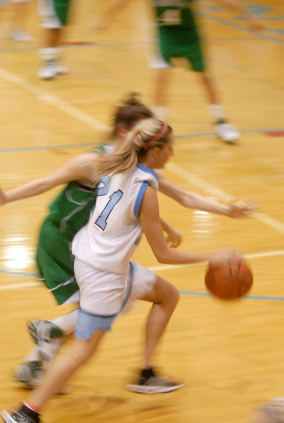

 In basketball, each team has five players on the court at one time. Player substitutions are unlimited but must be made during a dead ball stoppage and be recognized by one of the game officials (called a referee).
In basketball, each team has five players on the court at one time. Player substitutions are unlimited but must be made during a dead ball stoppage and be recognized by one of the game officials (called a referee).
The Game
Basketball is played on a court that has two basketball hoops (the net is 10 feet off the floor, but for younger kids (K-2) may be 8 feet off the floor) on each end. The court is separated into an offensive and defensive zone by the mid-court line. The offensive team (the team that has the ball) has ten seconds to advance the ball to the mid-court line (half court); if it doesn't, possession of the ball is turned over to the other team.
A player can move the ball around the court by passing to another teammate or dribbling. The team on defense tries to regain possession by stealing the ball, intercepting passes, and rebounding missed shots. Many youth basketball programs prohibit the defense from stealing the ball from the player handling the ball and allow steals only on a pass.
Each team has a basket to defend, and at halftime, the teams switch baskets. The game begins with two players (one from each team) at center court where a referee tosses the ball between the two (the "tip-off" or a "jump ball").
Each game is divided into halves and sometimes into quarters, depending on the level of play:
Pros: four 12 minute quarters. No running clock.
College: two 20-minute halves. No running clock.
Middle and high school: four 8- minute quarters. No running clock.
Youth level: two 20-minute halves, often with a running clock (the clock stopping only for dead balls in the last minute of each half)
When a team scores, there are a few things to remember:
If a shot goes in the basket from a player with both feet beyond the three-point line or arc, the made basket is worth three points ("three-pointer").
A basket made from the foul/free throw line is worth one point.
A foul committed when the player is in the act of shooting a basket results in two free throw attempts (three if the foul occurs while the player is attempting a three-point basket). One foul shot is awarded a player when he or she is fouled in the act of shooting but makes a basket despite the foul.
Fouls
Personal Fouls: A foul is committed when a player makes illegal physical contact with an opposing player. When the referee calls a foul, play stops. Some common fouls are:
Shooting fouls (hitting the arm or hand of a player in the act of shooting)
Pushing/Blocking/Over the Back: pushing a player or reaching over his back to try to gain a better position to rebound a missed shot
Reaching In: slapping the hand of a player to try to steal the ball (no foul if only touch the ball)
Holding or grabbing a player
Excessive contact that allows the player to gain an unfair advantage
Blocking the path of a defender trying to cover a player (illegal screen)
Knocking down a defender who has established his position on the floor (called "charging")
Personal Foul Penalties
Foul Terminology
Flagrant foul: Violent contact with an opponent (hitting, kicking, punching); This type of foul results in free throws plus the offense being given possession of the ball after the free throws.
Intentional foul: When a player makes physical contact with another player with no reasonable effort to steal the ball.
Fouling out: A player who accumulates five fouls in a game (six at the professional level) has "fouled out" and is automatically disqualified from further participation.
Violations
Traveling- Taking more than a step and a half without dribbling the ball, resulting in the ball being turned over to the other team. In recognition of the lower skill level of younger players (K-2), referees are often given discretion on whether to call a violation; if he does, he will explain the violation to the player and the violation does not result in a turnover.
Backcourt violation- Once the offense has brought the ball across the mid-court line, they cannot go back across the line while they have the ball. If they do, the ball is awarded to the other team on the sideline to pass inbounds.
Positions
Rule differences
Parents need to remember that the rules of basketball are often modified from those that govern at the college and professional level in recognition of the lower skill levels of youth players. Here are some of the major rule differences to watch out for:
The number of time outs per half may be less.
Zone defenses (defensive schemes in which defensive players are responsible for an area or zone of the court) may be banned in favor of strict man-to-man defenses in which each player guards a player on the opposing team
Pressing defenses and fast breaks may be prohibited, either for the entire game, or for the first three quarters, requiring the defensive team to set up at half court before the offensive team takes the ball up the court after a made basket, rebound or turnover.

Links:
[1] http://www.ultimate-youth-basketball-guide.com/basketball-referee-signals.html
[2] https://momsteam.com/forums
[3] https://momsteam.com/sports/youth-basketball-age-appropriate-rim-height-ball-court-team-size-increase-fun-skill-developme
[4] https://momsteam.com/sports/basketball/safety/youth-basketball-when-to-start-what-the-rules-are-and-how-to-stay-safe